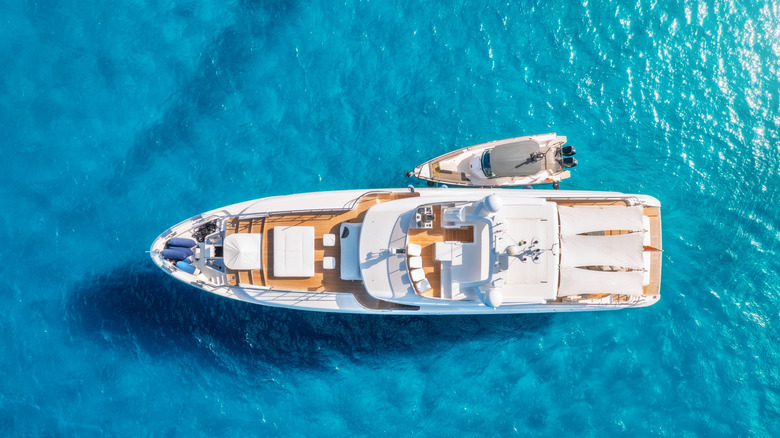The Reason Boats Can Be Such A Waste Of Money
A new boat will lose value, and fast. This is why it is often a purchase that older adults regret. According to YATCO's June 2025 report on yacht depreciation, a typical 50 to 70 foot long yacht can lose 10% to 20% of its value in just the first year (similar to what happens with most new cars), even if it is in perfect condition. However, some enthusiasts will dispute this. The Yacht Hunter's August 2024 report states that there is no exact formula for how fast a boat loses value. Instead, the condition of the boat, what similar boats have sold for, and the current market all play a role in setting the price.
Real boat listings show that a 10% drop in value during the first year is fairly accurate. One example is a used 52-foot 2022 Vicem Classic with just 50 engine hours. It was built for $1.8 million but is now listed for $1.2 million on Yacht World, a $600,000 loss, or 11% per year. This shows just how quickly high-end boats can lose value and, unlike automobiles, this value depreciates without the promise of being put to use every day. Worst of all, depreciation is just the start with boat owners also spending a lot on maintenance, storage, fuel, and repairs.
Other boat expenses to consider
Per a 2025 Bankrate report, boat owners should expect to spend about 10% of the boat's purchase price every year on basic upkeep. That means if you buy a $20,000 boat, you'll likely spend around $2,000 a year on routine maintenance, repairs, paint, and winter storage. Fuel is another big cost. A five-hour ride in a motorboat can use more than $300 in gas, with Pontoon boat owners often spending around $3,000 per year just to keep their fuel tanks full.
Storing a boat also often costs more than people might expect. Dry-stack storage runs $10 to $20 per foot each month, while marina slips can run anywhere from $20 to $50 per foot per month. Even a basic self-storage lot can cost between $10 and $40 per feet monthly. Or, if you plan to store your boat at home, you'll still need to buy a trailer, which can start around $700, plus the extra money required to winterize the boat and trailer. Since most boats spend more time in storage than they do on the water, these fees can add up fast.
Boat insurance is another cost. Per Progressive, average yearly premiums cost $267 in Minnesota and $839 in Florida from 2023 to 2024, depending on storm risk and how long the boating season lasts. On average, owners pay 1.5% of the boat's value each year, via Yacht World, so about $300 for a $20,000 boat or $3,000 for a $200,000 one. High-end yachts can cost even more to insure, sometimes up to 5% or 6% of their value.
Alternatives to buying a boat
The U.S. Coast Guard's 2020 boating survey found that the average owner only used their boat about 19 days a year — 29 days if it had a motor, and just 12 if it was paddled. This is why it is potentially more economical to have a boat club membership where you can use a boat without actually having to own one. Carefree Boat Club's 2024 pricing shows that users pay a one-time sign-up fee, with monthly dues between $150 and $375. If you go out twice a month, each trip would cost about $75 to $190, which can be a much better option than buying a boat, especially a brand new boat. This option can also provide variety. You might take out a pontoon boat one weekend and a fishing boat the next. The one downside is that if you don't regularly use your membership, you're paying to stay on land.
If you simply want to hit the water every now and then, consider renting a boat. GetMyBoat's 2024 prices show daily rates of between $200 to $600 for pontoons and $300 to $800 for speedboats. Ten trips at $500 each would run you about $5,000 total, which is less than what you'd spend in a year just on storing and insuring your own boat. Plus, instead of spending $60,000 to buy one, you can leave that money in an investment instead like a one-year Treasury note earning about 4.06%, per the U.S Department of Treasury as of May 2025, which would earn you around $2,400 in interest.


